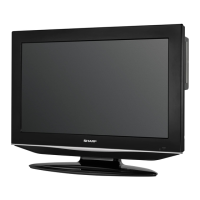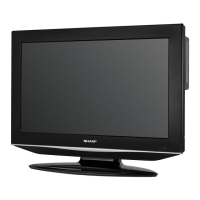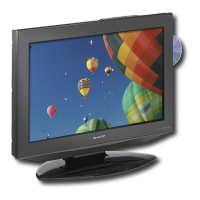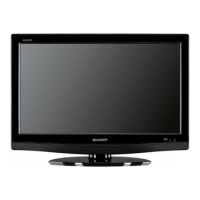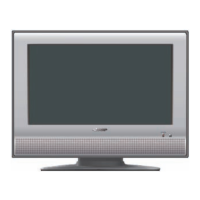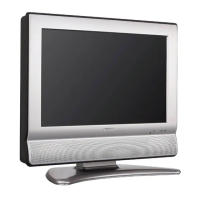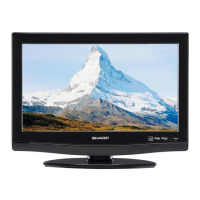MP3/WMA/JPEG and Audio CD operation
Loading CD
I Load a disc on which UP3 or WMA files have been
recorded inthe discslot.
2 "Reading" will appear on the TV screen. Reading time
willdepend on the number of files on the disc.
3 A file browser screen will appear on the TV screen.
F_ht
L t
3 : l_l_[es Mus_ fi_e(/u_io CDIMP3/WMA)
[] :Indites l_lc_lr_ _tle {JPr::_]
* In case the currentdirectory includes8 files or more,
press AI_' to scroll in the file list.
o To see contents in to}tier, select the folder and then
press ENTER. To return to the parent directory, select
"m Go Up ../' then press ENTER.
• In case of a CD containing a mixture of UP3, WMA
and JPEG files, the files are played back by selecting
them from the file browser.
2
3
Inthe file browser,press ,=tT to select the desired file.
• When PLAY is pressed after displaying file browser
displayed, playbackbegins automatically starting from
the first file. In this case, if the first file is an MP3/WMA
file_only MP3/WMA files are played back in order. If
the first file is a JPEG file, the first JPEG file isplayed
back. If there is no file at a root directory, playback
does not beginautomatically.
PressENTER.
The selected file starts playingback.
PressSTOP to end playback.
• The unit records the stopped point. "li_" appears on
the screen. Press PLAY to resume playback (fromthe
scenepoint).
• ]t you press STOP again or unloadthe disc, the unit
will clearthe stopped point.
• MP3 or WMA file on the Kodak Picture CD is not
recognized on this unit.
• During MP3/WMNJPEG-Playback, you cannot use JUMP
and A-B Repeat functions.
• You can use Repeat (Track or All), Random functions and
Program playback for MP3,,_NMAfJPEG-PIayback (see
page 30).
The file type to make it display in the file browser can be
chosen.
Press -q/_ to select "Select Files" at rightcolumn inthe
file browser.
• Press ENTER, then press ,tit to select file type from
the list (Music or Picture).
2 Press ENTER to add/remove check mark. Checked file
type will be displayed in the file browser.
3 Press RETURN to save the setting.
JPEG playback
Inthe file browser, press ,L/_r toselect the desired JPEG
file.
To display athumbnail list, press DVD MENU.
Press _It_-IA/T to select the desired file.
(To return to the file browser, press TOP MENU.)
• When PLAY is pressed after displaying the file
browser, playback begins automatically starting from
the first file. Inthis case, if the first file is a JPEG file,
the first JPEG file is played back. If the first file is an
MP3At_iMAfile, only MP3!WMA files are played back
in order. If there is no file at a root directory, playback
does not begin automatically.
Press ENTER. The selected picture appears on the
screen.
3
Rotating an image
You can rotate an image by 90 degrees.
Press ANGLE during playback of the image.
"i_,", "_", "_" or "_" appears on the screen.
Zooming an image
Zoom function also can be used in viewing JPEG files.
Press ZOOM (see "Zooming" on page 26).
Press STOP to end playback.
• The file browser appears on the screen, if you want to
watch the other file, repeat steps 1 - 2.
• When an image exceeds 5760 x 3B40 pixels, the entire
image cannot be displayed on a screen, preview window
or thumbnail list.
L" i ¸ _ :: F ": .... " _ •
The slide showenables you to view pictures (files) one after
another automatically.
Preparation"
Set °JPEG Interval" setting to "5 Seconds", "10 Seconds" or
"15 Seconds" (see page 31).
1 Select your desired starting tile for the slide show in step
1on the left.
Press ENTER or PLAY to start slide show from the
selected file.
• If you press STILL/PAUSE during the slide show, the
slide show stops temporary. "I1" appears briefly on the
screen.
• If the picture appears upside down or sideways, press
ANGLE repeatedly until it's right side up. "1_.", "_",
"÷_" or "_" appears on the screen.
• Press PLAY or SKIP _ again to resume the slide
show.
• When the slide show playback finished, the file list
appears.
• To stop the slide show, press STOP. The file list
appears.
• During JPEG playback, you cannot use Direct Skip and
A-B Repeat functions.
• It may have a longer interval due to a size of data.
(_- 29

